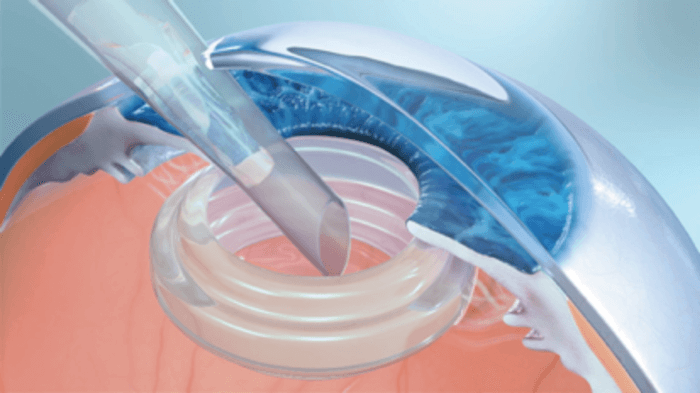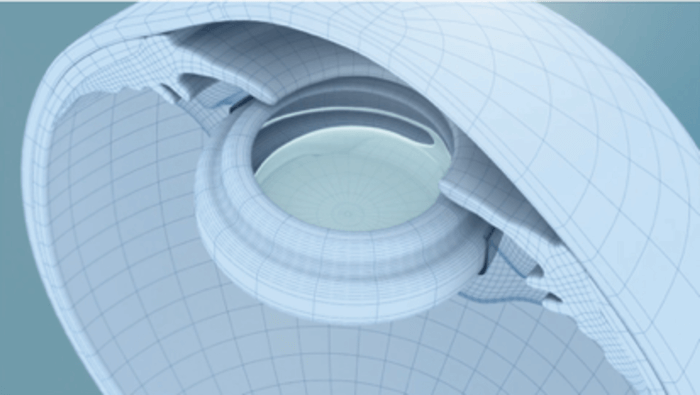
Two years out of my residency, I was frustrated with the disconnect between performing a successful cataract surgery, and achieving imperfect refractive results. I started thinking about why so much refractive variability exists in cataract surgery, and it suddenly struck me that we are removing a 4–5 mm thick cataract and allowing the capsular bag to collapse around a 1 mm thick optic. The final resting position of the optic determines the effective power of the lens. There had to be a better solution than simply leaving this to chance. My idea? To find a way to keep the capsule in its native extended volume and insert the lens in a way that would provide a defined plane to perform intraoperative measurements and calculations. If we could create a platform to keep the capsular volume essentially unchanged, there would be a much better chance of the lens being positioned in the middle of the bag after surgery. Although cataract volume and capsular bag size differs between individuals, they fall into a fairly narrow range, which led me to design the Gemini refractive capsule: a form-fitting capsule platform made of a flexible silicone polymer that is essentially a ‘one size fits all’ device (see Box: The Gemini Refractive Capsule). The capsule itself doesn’t have any refractive power, but has been engineered to be compatible with all popular available IOLs, as well as compatible with intraoperative aberrometry to ensure accurate refractive outcomes. A channel in the midpoint of the Gemini refractive capsule holds the IOL haptics to maintain the optic in a stable position.
A journey into open space
But my aim wasn’t just centered on providing a potential solution for reducing refractive variability – I also wanted to offer more in terms of adjustability and integration with other technologies. We anticipate that exchanging IOLs from the capsule would be very easy. The most difficult part of a traditional lens exchange is removal from the natural capsule because the capsule collapses and causes fibrosis after IOL insertion. As all optics inserted into the Gemini refractive capsule are protected from the natural capsule, rather than having to ‘tease’ out the haptics from a compressed and fibrosed capsular bag, the IOL can simply be removed from its silicone capsule. Although the Gemini refractive capsule is designed to be compatible with any traditional C arm haptic IOL, we have also designed a proprietary optic – Bravo – that can fixate onto the back surface of the capsule. As this leaves the rest of the capsule unoccupied, there are options for ‘piggyback’ lenses that can sit in the center of the Gemini refractive capsule in the event that further refractive corrections are required. Leaving the center of the Gemini refractive capsule unoccupied also provides the option to insert other devices such as wireless pressure sensors or drug delivery devices. Because we have the opportunity to separate lenses by a few millimeters, there is also the ability to create a complex lens system like a reverse Galleon telescope. We could actually insert a lens on the back surface and a lens on the top surface to create a low vision aid for patients with macular degeneration or other low vision challenges. Each surgeon can potentially build on our platform whatever they want. A patient might not need a pressure sensor or a low vision aid upon primary implantation, but if they develop glaucoma or macular degeneration later, the system can be modulated to accommodate those events. From animal studies conducted in the Mamalis and Werner laboratory at the University of Utah, the Gemini refractive capsule was shown to fit and center itself within the eye (1). In the first part of 2018, we performed a first-in-human trial in Panama. The capsule was implanted in a total of eight patients, and we have seen very good results with all patients doing well. As well as achieving good refractive results, there were no incidences of PCO; the natural capsule does not opacify at the same rate when it is held open by a refractive capsule. We are currently planning a 30-person trial outside of the US that should be starting in Q4 of 2018. We are also planning another animal trial at the University of Utah to test some advanced pressure-sensing technology in the capsule.- The Gemini refractive capsule is a circular capsule with a 6 mm opening at the top and the bottom.
- The capsule can be compressed to a small size, and injected through a 2.1 mm injector. Current human trials are investigating the capsule through an 2.4–2.75 mm incision.
- The capsule is engineered to hold a single piece acrylic IOL, and is compatible with the most popular available models. IOLs can be inserted as part of the primary implantation procedure, and IOLs can be upgraded or replaced in the future.
- The capsule is engineered to work with intraoperative aberrometry.
- The open space and protective environment inside the capsule could provide a platform for drug delivery devices and biometric sensors, as well as new intraocular technologies, such as augmented reality.



The future is open…
I believe that keeping the capsular bag open and accessible could hold the key to the future of ophthalmology. Right now, we are performing refractive lensectomies on patients who are in their 40s and 50s who have 30 or more years left to live. But we know – and hope – that lens technologies are improving and that we might reach the point where we have accommodating lenses available. The problem is that any patient operated on now will not be eligible for such new technologies when they become available. By keeping the capsular bag open with our Gemini refractive capsule, there will finally exist the option to adjust or upgrade to newer technologies. We envisage that our Gemini refractive capsule will represent a platform for all cataract surgeries, whether standard or premium, that will give surgeons and patients further viable options down the road. There is even scope for truly advanced technologies, such as augmented reality – watch this space, as the future is open to anything. Gary Wortz is an Ophthalmic Surgeon at Commonwealth Eye Surgery, and Chief Medical Officer, Omega Ophthalmics, Lexington, KY, USA.References
- Omega Ophthalmics. “Omega ophthalmics receives successful animal study results”. Available at: http://bit.ly/2NM6D6L. Accessed: September 4, 2018.
